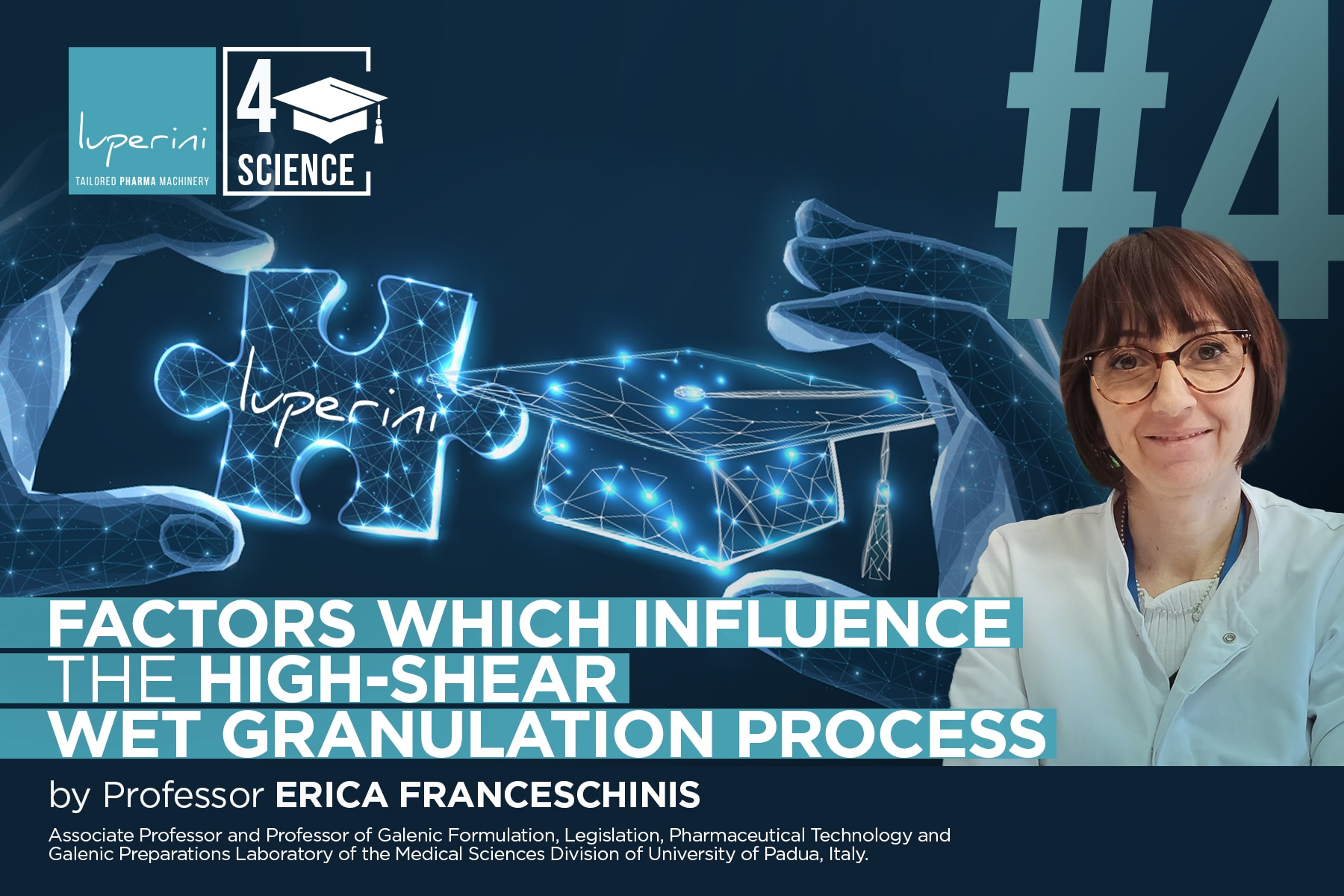
We proudly present the fourth chapter of our scientific collection “Luperini Science”, created by Luperini Tailored Pharma Machinery in collaboration with Professor Erica Franceschinis (University of Padua). This chapter provides crucial information and updates on the process and granulation technologies in the pharmaceutical field.
Discover how this information can help you to improve your professionalism in this industry.
Factors affecting the high-shear wet granulation process
Several factors influence the high-shear wet granulation process that can be divided in formulation and experimental variables.
Formulation variables
The main formulation variables that affect HSWG are:
Solubility of the different components: This parameter mainly affects the growth rate of the granules. Indeed, materials characterised by high solubility are associated with a higher tendency to have uncontrollable growth. In addition, if the API is highly soluble in the binding liquid, during the drying process, intergranular and/or intragranular migration may occur, potentially leading to issues of content uniformity in the final granulate.
Wettability (contact angle): is an important parameter because it affects the wetting phase of the process and thus the final granule distribution. In addition, the wettability can affect the entity of the liquid bridges and thus the size of the final granules; infact, the poor wetting of the powders leads to the formation of smaller nuclei and weaker liquid bridges between the hydrophobic particles.
Particle size and surface area: they have an important role as they can lead to powder segregation, especially during the dry mixing, which can cause a non-homogeneous distribution of the active ingredient. Moreover, the size of the starting material can have a strong effect on the densification and compactability of the resulting granules. In particular, coarse and large materials lead to larger and less porous granules. Additionally, these parameters affect the amount of liquid required for the process.
Experimental variables
The main process parameters that affect HSWG are:
bowl fill level, impeller speed, amount of granulating liquid, method of binder addition, liquid addition rate, and granulation time.
Impeller speed: It has a great influence on granule growth and granule properties (e.g. PSD, porosity, and strength) because it changes the equilibrium between the growth and breakage phenomenon.
Impeller speed effects depend on the characteristics of the processed wet mass and the granules mechanical properties.
The amount of granulating liquid: It has a great influence on properties such as granule size distribution, granule growth, porosity, and tensile strength. Higher amounts of granulating liquid lead to the production of larger and denser granules.
Granulation time: In the massing phase, granules undergo coalescence and consolidation, and the duration of this phase significantly impacts granule characteristics, including size, shape, strength, and porosity. Additionally, it plays a crucial role in determining the properties of the resulting tablets, particularly their dissolution and disintegration rates.
Binder addition method: Two main techniques of binder addition are available: wet binder addition and dry binder addition. In the first method, the binder is dissolved in a solvent and the resulting solution is subsequently added to the powder mixture. Instead, the second approach involves mixing the solid binder with dry powders and activating it during the wetting phase. The first method is mostly used because it leads to the formation of smaller granules. The droplet size of the binder solution affects the distribution of the binder among the powders and therefore the nucleation mechanism. A smaller droplet size results in a more even binder distribution and a narrower granule size distribution.
Fill level of the mixing bowl: It affects the flow pattern of the granules and thus the mixing efficiency, which has an impact on the dosage uniformity of the final product. The literature reports that the fill level should not exceed 2/3 of the volume of the mixing bowl to guarantee the optimal distribution of the binder solution and a broad granule size distribution.
Liquid addition rate: It can affect the efficiency of the liquid spreading into the powder bed, and thus the final granule distribution.


